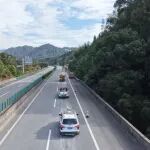目录|《公路交通研究(英文)》(HTRD) 2025年第2期
01
Roadside LiDAR for C-ITS: placement, calibration, and fusion of perception
Changlong Zhang, Wei Zhou2,3, Zhichao Liu2,3, Pengcheng Xie, Wang Li, Jian Ou, Haixing Bao, Jimin Wei, Yi Wang
Abstract:The ongoing transition from Intelligent Transport Systems (ITS) to Cooperative Intelligent Transportation System (C-ITS) facilitates the coexistence of connected vehicles (CV) and conventional vehicles. Roadside Light Detection and Ranging (LiDAR), leveraging its precise target detection capabilities, compensates for the sensing limitations of CV. But its performance is limited by the placement and calibration of roadside LiDAR systems in engineering projects. To address these challenges, this paper introduces a solution that combines roadside LiDAR with Cellular Vehicle-to-Everything (C-V2X) technology. To enable rapid deployment and calibration of roadside LiDAR at real-world environments, the study simulates a road segment environment using a real intersection and analyzes the distribution of LiDAR point clouds within the Roadside LiDAR Occupation Board (RSLOB). By calculating two indicators-Roadside Density (DRS) and Roadside Normalized Uniformity Coefficient (CRSNU)-the optimal installation angle for roadside LiDAR in real-world scenarios is determined. To overcome the limitations of existing roadside LiDAR calibration methods, this study proposes a C-V2X-based calibration method that converts LiDAR coordinates to the World Geodetic System-84 (WGS-84) coordinates. The calibration experiment results show that 97.08% of the validation points meet the accuracy requirements. Furthermore, recognizing the redundancy between the target data provided by roadside LiDAR and the broadcast data from CV, we propose a data fusion method. The experimental results show that this fusion method effectively resolves the redundancy between the information broadcast by roadside LiDAR detecting CV and the data broadcast by the CV themselves. This study lays the foundation and performs crucial groundwork for the application of LiDAR on the roadside, aiming to facilitate widespread adoption in the future.
02
Clustering analysis of vehicle traveling and parking behavior based on license plate recognition data: Suzhou case
Kexin Wang1,2, Xiang Wang1,2, Xiangxi Liu, Yutong Wang
Abstract:The regularity of vehicle travel patterns is a crucial characteristic of urban traffic operations. Analyzing these patterns yields valuable insights for traffic management and urban planning. With the advent of big data technology and intelligent transportation systems, accurately identifying traffic demands and profiling traveler behavior has become practical. In this study, we leveraged license plate recognition data to cluster and analyze the travel characteristics of vehicles in Suzhou city. Initially, the Suzhou license plate recognition data underwent preprocessing to rectify errors and eliminate redundancies, thereby enhancing data accuracy. Subsequently, a threshold segmentation technique was applied to partition the travel sequences. Finally, a suite of indicators, including parking habits, driving behavior, and driver attributes, were extracted. Travelers were then categorized using the K-means++ clustering algorithm to discern the characteristics of different vehicle user groups. The findings suggest that: (1) Low-frequency foreign vehicles constitute 82.36% of the total foreign vehicle population and contribute 46.11% to the overall foreign travel intensity. High-frequency foreign vehicles, which make up only 2.72% of the total foreign vehicle count, significantly contribute 24.6% to the foreign vehicle travel intensity, highlighting their importance as users of road resources. (2) Travelers are classified into four categories: Light Commuters, Daily Commuters, Weekend Explorers, and Balanced Travelers. Notably, Light Commuters and Daily Commuters display marked differences in both their travel and parking behaviors. This research offers policy recommendations tailored to different vehicle user groups and provides data-driven insights for addressing urban transportation challenges.
03
Severity analysis of property damage in highway accidents
Yucong Hu, Wenhan Shi1,3, Hu Wei, Qiang Zeng
Abstract:Accident data collected from 2014 to 2019 for the Dongguan section of the Guangshen Yanjiang Expressway in China were utilized to investigate the key factors influencing the severity of road property damage in highway traffic accidents. The spatial correlation among adjacent accidents was addressed using a spatial generalized ordered Probit model, which employed varying association distance thresholds. An XGBoost machine learning algorithm was developed to estimate the model parameters, and the SHAP (SHapley Additive exPlanations) method was employed to elucidate the model outputs. The results show that significant spatial correlations are present within the accident data. The spatial generalized ordered Probit model demonstrated superior performance compared to the conventional generalized ordered Probit model, with the model based on a 200 m association distance threshold yielding the best results. The SHAP method significantly enhanced the interpretability of the XGBoost machine learning model. Parameter estimation revealed that variables such as single-vehicle accidents, passenger cars, lorries, heavy tractors, nighttime occurrences, early morning periods, cloudy conditions, rainy conditions, and bridge locations were significantly associated with the severity of road property damage resulting from traffic accidents.
04
Control strategies for multiple transportation modes in urban road networks
Zhonghe He, Jianming Wang, Jiaxin Wang
Abstract:The study leverages the three-dimensional Macroscopic Fundamental Diagram (3D MFD) model for urban road networks and constructs a refined 3D MFD model utilizing the actual movement trajectory data of diverse vehicles within the experimental region. The boundary control strategy for mixed traffic flow within the designated control area is developed. This strategy involves determining the traffic flow balance model of the road network through the boundary control process. Additionally, a Proportional-Integral (PI) controller is designed based on the feedback control model of the road network's boundary. The primary control objectives for the boundary management of mixed traffic flows are societal vehicles, with no restrictions imposed on the entry of public transportation vehicles into the controlled zones. The weight assigned to public transport vehicles in the control decision-making process is determined by allocating the proportion of mixed traffic flow at the boundary intersection that enters the controlled area. The efficacy of the proposed control strategy is evaluated through simulation experiments, comparing its performance against existing methods.
05
Dynamic optimal scheduling of airport special vehicles in complex operating environment
Yonghong Liu, Min Peng, Zhihong Zhang, Jicheng Yang
Abstract:Amid the swift expansion of the aviation industry, enhancing service capabilities has emerged as a critical focus for aviation companies seeking to bolster their competitive edge. Ground support services for flights are pivotal in ensuring the smooth operation of air travel. With the dynamic fluctuations in flight schedules, optimizing the allocation of airport ground service vehicles has become essential for enhancing support capabilities. This study focuses on the refueling vehicle as a case study and develops a dual-objective mixed integer programming model aimed at minimizing both the number of vehicles required and the total time spent on waiting, driving, and resource supplementation for special vehicles. An iterative algorithm, integrating the rolling time domain approach with the multi-chromosome band elite strategy from the non-dominated sorting genetic algorithm (NSGA-Ⅱ), is designed to solve the model. Experimental outcomes confirm the feasibility and efficacy of the proposed model, demonstrating its ability to effectively address special vehicle scheduling challenges within complex operational environments. This research provides a practical methodology for maximizing the utilization of airport resources.
06
Dynamic allocation of regional shared parking spaces based on assignment problem model
Shuo Zheng, Ruijun Guo
Abstract:To address the issue of inefficient parking space utilization resulting from temporal and spatial disparities in parking demand, shared parking emerges as an innovative traffic management paradigm. The core concept of shared parking lies in the strategic allocation of parking spaces. By analyzing the usage patterns of parking areas, the relationship between supply and demand over time can be represented in a binomial form. An integer programming model for parking allocation is formulated, where the objective at each allocation stage is to minimize walking distance and parking costs while maximizing the degree of temporal alignment with overall parking demand in the region. The weights of these three indices are calculated using the entropy weight method, and subsequently, the parking cost matrix is derived through linear weighting. It is proposed to utilize the Hungarian Algorithm as a method for solving the assignment problem to obtain the allocation scheme that minimizes total parking costs. A Python program is developed to execute the phased optimal allocation of parking spaces. At the conclusion of the operation, the results for overall parking demand satisfaction, parking space utilization, and parking costs are generated. The model is applied to parking space management in both real-world instances and simulation experiments. The results demonstrate that the model not only ensures a higher utilization rate of parking spaces but also effectively reduces overall parking costs and the idle rate of parking time compared to the current parking methods. This model is well-suited for the parking allocation processes of smart parking platforms.
07
Location selection of bicycle sharing delivery points based on rebalancing supply and demand
Hanqiang Qian, Yanyan Chen, Shuyan Zheng, Yue Shi
Abstract:As a green travel option, the bicycle sharing system has seen rapid development in recent years. Where to put the repaired bicycles and new bicycles becomes a real problem. It is necessary to help the bicycle sharing system rebalance the supply and demand. Moreover, it is also important to ensure the quickly use for new bicycles. Based on the realistic demand for bicycle sharing, this paper designs a strategy to select the location of bicycle sharing delivery points. The strategy considers the current supply and demand as well as travel intensity. Based on mobile signaling data and bicycle sharing data, the potential demand for bicycle sharing use is identified firstly. Next, the distribution of bicycle sharing is recognized. Then the supply and demand of bicycle sharing are analyzed. Finally, travel hotspots are identified and the location of bicycle sharing delivery points is extracted. Taking Beijing as a case study, more effective delivery points within the fifth ring road were identified. The application of the method can help improve the operational efficiency of the bicycle sharing system and promote the sustainable development of urban transportation.
08
Optimization of delivery routes for takeout under time-varying road networks
Jiaci Wang, Liang Huang1,2, Yuanqiao Wen1,2, Yamin Huang1,2, Man Zhu1,2
Abstract:Food delivery has emerged as a crucial aspect of the dining experience, driven by the proliferation of the Internet and the expansion of the catering industry. Delivery times have become a significant factor affecting customer satisfaction. However, the inherent unpredictability of the delivery process can lead to delays, which in turn can diminish customer contentment with the delivery platform if the actual delivery time surpasses the promised time frame. Consequently, this paper addresses the optimization of delivery routes for couriers who encounter uncertainty during their deliveries. To quantify the randomness of the distribution process, the study introduces a random influence factor that accounts for road obstacles and weather conditions. Different coefficients for road obstruction and weather influence are assigned to various road sections and delivery times to accommodate the stochastic nature of static road segments. Based on this, a takeout delivery optimization model that incorporates stochastic elements is formulated. This model is designed to effectively optimize the delivery plan, achieving a balance between delivery costs and customer satisfaction. The proposed model is solved using a taboo search algorithm. The effectiveness of the delivery model and algorithm is validated through simulations that compare the performance of the delivery route model under different weather conditions and road obstacle coefficients. The objective of this study is to assist delivery couriers in planning their routes in a rational and scientific manner to enhance delivery efficiency while managing the uncertainty of the road network. Additionally, the research aims to provide practical recommendations and solutions to reduce delivery operation costs and improve customer satisfaction.
09
Urban bus networks’ emergency management for interdicting major emerging infectious diseases’ early transmission
Yue Pan, Ruojian Li, Hongsheng Qi
Abstract:In the early stages of major emerging infectious disease outbreaks, the transportation sector must identify bus stops with high relative accessibility to the risk area and interdict the accessible path, i.e., the shortest path, to regulate the spread of the outbreak within the transit system. Thus, this paper proposes a novel multi-sink shortest-path network interdiction model that incorporates accessibility measures in the reverse direction for the first time. The model consists of two steps: first, a detailed index of transit system accessibility is constructed; second, based on the accessibility definition, the accessibility path interdiction is formulated as a bi-level bi-objective programming problem. The upper-level planning aims to minimize the accessibility and traffic control cost of the transit system at bus stops in the epidemic risk area. In contrast, lower-level planning involves solving the shortest path search problem. An example network is applied to validate the proposed model and algorithm’s effectiveness, and the results show that the model is valid. Moreover, computational experiments evaluate the model’s performance in a large-scale network. The proposed model can compute the optimal decision in only 200 seconds in a real-case application.
10
Least square algorithm for correcting high voltage arc edge discharge parameters
Zhixin Ou
Abstract:The catenary system is a critical component of the electric traction power supply infrastructure; it is tasked with the stable conveyance of current to electric locomotives. As the catenary lacks a backup system, it experiences an increased incidence of arcing and dust accumulation during operation. This can lead to fluctuations in power quality, particularly when arc edge discharge conditions are met under specific climatic circumstances, which are able susceptible to arc ignition. Such occurrences can severely compromise the structural integrity of the catenary equipment and disrupt the geometric parameters of the system. Firstly, the paper analyzes the nonlinear output characteristics of catenary safety features and edge discharge parameters within the system model. The least squares method is employed to identify the nonlinear model and to optimize error parameters in real-time. Secondly, transient overcurrent parameters and the characteristics of catenary equipment, including edge discharge and arc-induced pollution flashover, are simulated using specialized simulation software. Lastly, by comparing the simulation results with the real-time operational curves of the experimental equipment, the study concludes theoretically that parameter optimization based on the least squares method offers the most effective means of stable and adaptive adjustment for model identification.
Journal Introduction
HTRD
The Journal of Highway and Transportation Research and Development (English Edition) (HTRD) was established in 2006 as a leading academic journal under the sponsor of the Research Institute of Highway, Ministry of Transport, published quarterly by the Journal of Highway and Transportation Research and Development Co., Ltd. As of 2024, the journal is co-published by Tsinghua University Press and has transitioned to an Open Access Journal. Articles co-published between 2006 and 2023 are available for access at https://ascelibrary.org/journal/jhtrcq.
HTRD is an international Englishscientific journal. HTRD’s topics include civil engineering (road, bridge,tunnel), traffic engineering, intelligent transportation, environmentalengineering, transport economics, automotive engineering, logistics engineering,disaster prevention, etc.
Sponsor: Research Institute of Highway, Ministry of Transport.
Co-publisher: Tsinghua University Press (2024-).
American Society of Civil Engineers (ASCE) Library (2012-2023).
Indexed: DOAJ, ProQuest, INSPEC, Ulrich, CA, AJ VINITI, WJCI, COPE.
期刊官网:
https://www.sciopen.com/journal/2095-6215
投稿网址:
https://mc03.manuscriptcentral.com/htrd
公路交通科技
中文刊:https://www.gljtkj.com/CN/home
英文刊:https://www.sciopen.com/journal/2095-6215
来源:《公路交通科技》杂志社
编发:办公室
声明:本文系转载自互联网,请读者仅作参考,并自行核实相关内容。若对该稿件内容有任何疑问或质疑,请立即与铁甲网联系,本网将迅速给您回应并做处理,再次感谢您的阅读与关注。
不想错过新鲜资讯?
微信"扫一扫"











